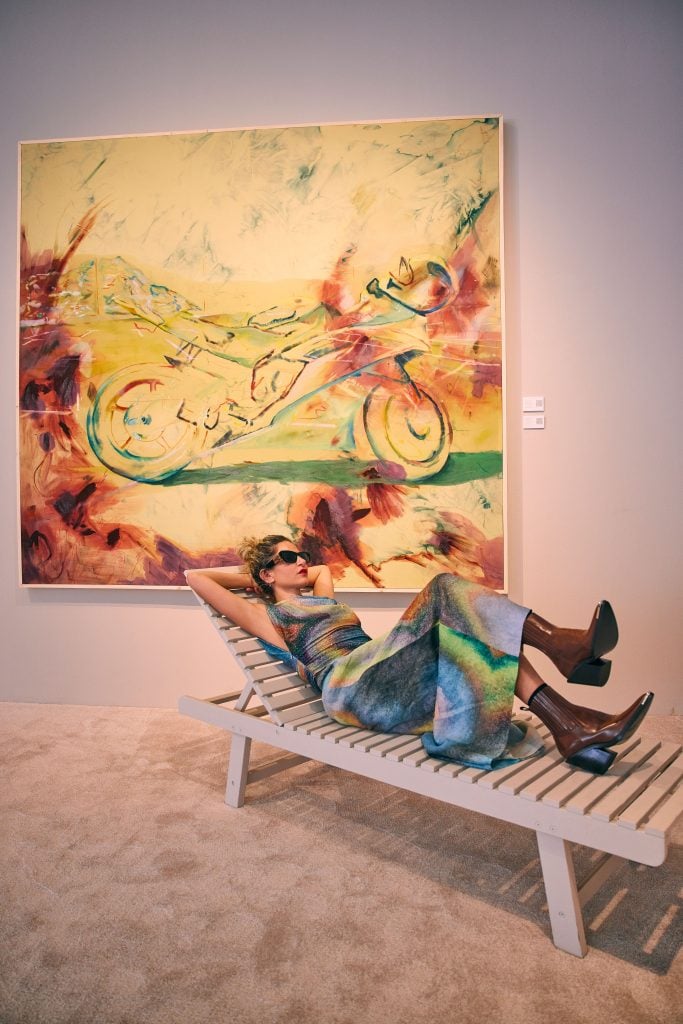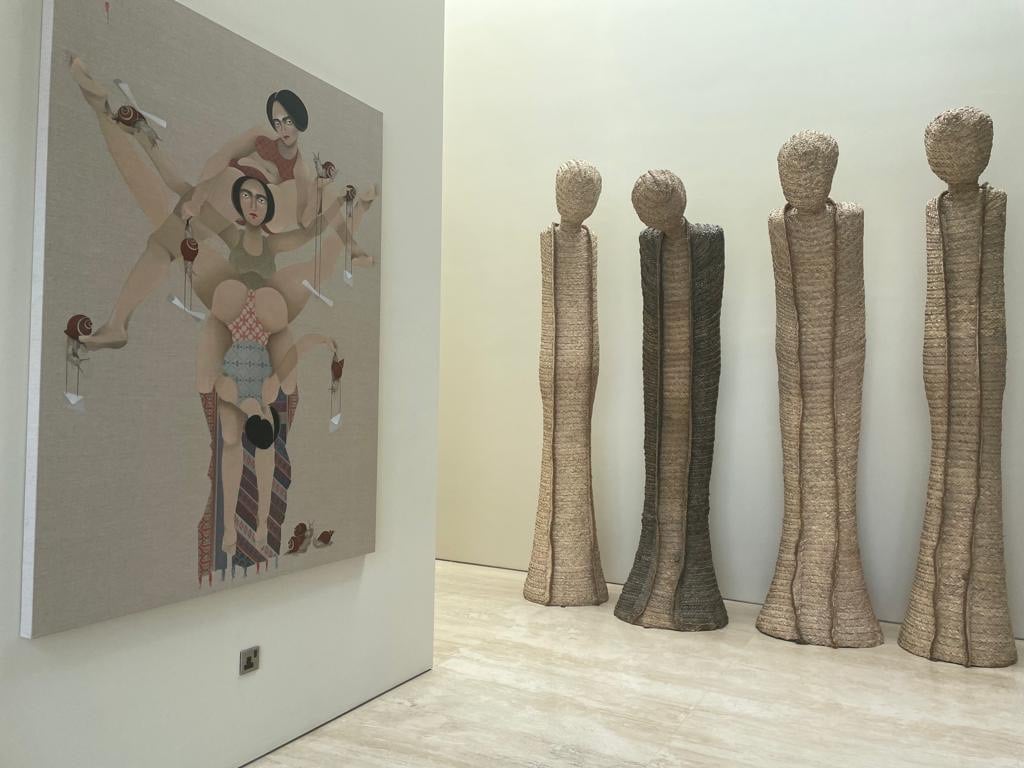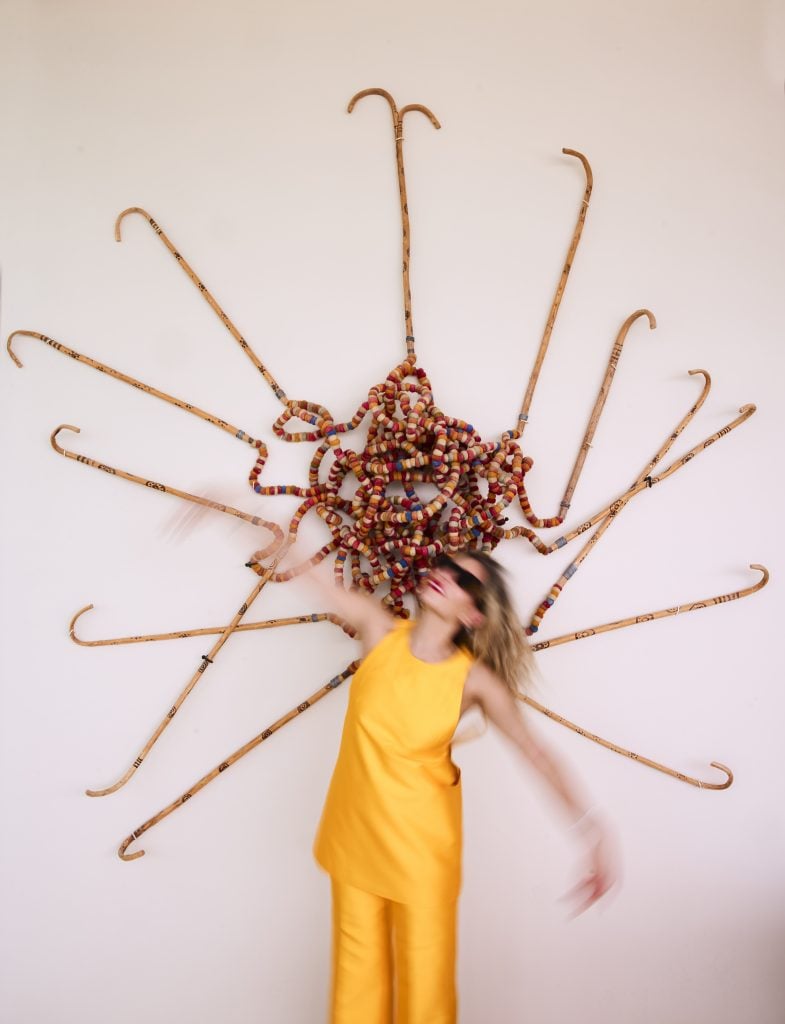Art Collectors
‘It’s a Bricolage Across Time, Place, and Approach’: Gallerist Maliha Tabari on Her Art Collection at Home in Dubai
The gallerist and collector behind Tabari Artspace showed us around her art-filled abode.

The gallerist and collector behind Tabari Artspace showed us around her art-filled abode.

Dorian Batycka

Located in Dubai’s International Financial Centre (DIFC), a stone’s throw from the Christie’s and Sotheby’s outposts in the Emirates, Tabari Artspace has played a pivotal role in connecting audiences to contemporary art in the Middle East and North Africa (MENA) region since it first opened in 2003. And in the meantime, owner Maliha Tabari has herself become a fixture on the international art circuit.
As a Palestinian national, Tabari spent much of her youth between Jordan and the Gulf, predominantly in Saudi Arabia during the 1990s, before immersing herself in America and then finally returning to Dubai. Visiting studios in Egypt, Syria, Lebanon, and beyond, she befriended the Egyptian master sculptor Adam Henin while uncovering then-emerging talents such as Hussein Madi, Adel El-Siwi, and Khaled Zaki—artists whose works can now be found in the collections of the British Museum, the Guggenheim, and LACMA, and whose careers Tabari helped shape over the last two decades.
Today, the gallerist remains committed to discovering new talent from a range of generations, geographies, and cultures, while nurturing and cultivating appreciation for Middle Eastern artists internationally. She also supports a number of artists through her personal collection.
Tabari’s home, a villa on the Palm in Dubai, is brimming with art (her residence in Montreux, Switzerland is, too). By her own estimation, she owns over 200 works. She told Artnet News about some of her favorites, as well as her approach to collecting and living with art over time.

From above: Ahmed Mater, Magnetism (2012) and Safwan Dahoul, Dream (2015). Courtesy of Maliha Tabari.
What was your first purchase (and how much did you pay for it)?
A jar by Farhad Moshiri, purchased in 2003 at $1,500.
How did your upbringing shape your interest in art?
I came from an open-minded and well-traveled family, so I was exposed to multiple cultures and social contexts at a young age.
I also went to an all-girls school in Saudi Arabia and was surrounded by strong women who were always actively and creatively seeking out avenues of expression. The dualities of open and closed societies I existed between have definitely imprinted upon my character and my heightened sensitivity to the world around me.
I think those faced with limitations often find the most imaginative ways to express themselves—some of the greatest art of our time has come from such spaces. I find many women from Saudi Arabia who grew up during my era to be bold, accomplished, and determined in their chosen fields, and I wonder if this is because self expression felt all the more critical to them.
When it comes to expression in art, I find many that spring from the MENA region to be highly gestural. We speak and express our realities with our hands and movements. This filters into the art produced.
For example, Maitha Abdalla paints with her fingers and traces around her figure in charcoal, while Tagreed Darghouth passionately applies impasto layers onto her canvas.

Tabari at home with Hashel Al Lamki, LOBSTER, 2022. Courtesy of Anastasia Sydorchenko.
What was your most recent purchase?
A piece by the self-taught Algerian artist Baya Mahieddine.
Cubist and Modernist movements in the MENA region have greatly contributed to my collection. Many of the Modern masters from the region were schooled in European institutions and interacted with the leaders of these movements before returning to the region and translating these influences in dialogue with everything that surrounded them. The result was a powerful embodiment of cultural exchange between East and West.
(This is also witnessed in artists that I’ve collected such as Parviz Tanavoli, founder of the midcentury neo-traditional Saqqakhana movement in Iran, whose art formed a fusion of folkloric traditions and contemporary expression; and Hussein Madi, who combined Modernist techniques with the subject matter that he encountered in Beirut.)
Baya’s personal narrative deeply resonates with me. I find her art is testament to the lesser-known flow from East to West. She was a pioneer, a female artist who had a palpable influence on the likes of Picasso—she is said to have influenced his Les Femmes d’Alger series, for example.
There has been much work done recently to revisit and re-author histories in our lifetimes. When I collect works, I consider them to be a snapshot of a particular moment of time. As such, the experiences of women like Baya and their influence on the art world are integral to recalibrating some of these lesser-known art histories.

From left: Hayv Kahraman, Snail (2021) and Ahmed Askalany, Guardians (2007). Courtesy of Maliha Tabari.
Where do you buy art most frequently?
I purchase art from fellow galleries to contribute to the regional art ecosystem and the careers of their artists, as well as from consultants and auction houses and smaller art fairs that offer intimate opportunities for engagement.
I also always buy from the artists I work with and represent. I have a belief in their ability and an appreciation for their output. And I have a track record for identifying artists from the MENA region that tend to go up in value as their careers progress.
How do you approach installing and living with art in your home? Do you ever get bored of works you’ve acquired?
I started to collect when I was 21, which has resulted in decades spent with certain works, particularly pieces by Middle Eastern Modernists. Do I get bored of these works? Never! I’m constantly playing with them, placing Modernists next to contemporary artists or those from different disciplines or locations that I encounter on my travels.
When you enter my home you’ll encounter Modern and highly contemporary pieces—paintings, installations, and sculptural pieces—in one space, in compositions that are always changing. It’s a bricolage across time, place, and approach, and a way to understand and appreciate older works anew. I like to establish new connections and spark the question: what do these artworks mean now, when placed side by side?

Tabari’s dining room is adorned with works by Paul Guiragossian, Hussein Madi, Sliman Mansour, Fateh Moudarres, and Adel El-Siwi. Courtesy of Maliha Tabari.
Your wardrobe is almost as bold as your art collection. What does fashion mean to you?
I’m constantly informed and inspired by that which I encounter in daily life—nature, art, cooking, design, architecture, and fashion—worlds that constantly borrow from one another.
I’m very tactile and love to layer and juxtapose interesting combinations in material, pattern, and form. I express myself through unique combinations sourced from the runway, vintage pieces, and those from emerging designers. Today for example I’m wearing a dress from my sister’s brand, All Things Mochi; her kaleidoscopic collections have a global aesthetic.
For me fashion is an art, a continuation of my passions and preferences that play out on the body.

Tabari next to Mohamed Arejdal, Moyen-Situation, 2020. Courtesy of Anastasia Sydorchenko.
What work do you have hanging above your sofa? What about in your bathroom?
HollyLand, a large-scale mixed media piece by Palestinian visual artist Hazem Harb, overlooks my living space. The work features acrylic lettering spelling out “Hollyland,” in Hollywood’s ubiquitous font, upon an archival photograph of historic Palestine.
The piece embodies multiple ideas and conflicts—faith and consumerism, celebrity culture, the holy and the mass. It is important to me as it encourages reflection upon social values and priorities while also aligning Palestine’s landscape with the magical and constructed world of cinema.
In my bathroom, I have a painting by the Emirati artist Maitha Abdalla. Her practice reflects upon the dualities of right/wrong, sin/purity, as well as the regional folklore and mythologies that have shaped her personal world.
I first met Maitha several years ago in her Abu Dhabi studio and her trajectory has been astounding to follow. She’s now exhibiting internationally and being acquired by significant public and private collections. The way that she paints with her fingers and uses her body on the canvas, in addition to her compelling subject matter, lured me in.

A painting by Emirati artist Maitha Abdalla hangs in Tabari’s bathroom. Courtesy of Maliha Tabari.
What work do you wish you had bought when you had the chance?
To this day I wish I’d acquired a piece by the trailblazing feminist Lebanese poet and visual artist Etel Adnan, who sadly passed away last year. Beyond the power of her color-fueled paintings, as an individual, Etel tirelessly challenged conventions and paved the way for those behind her.